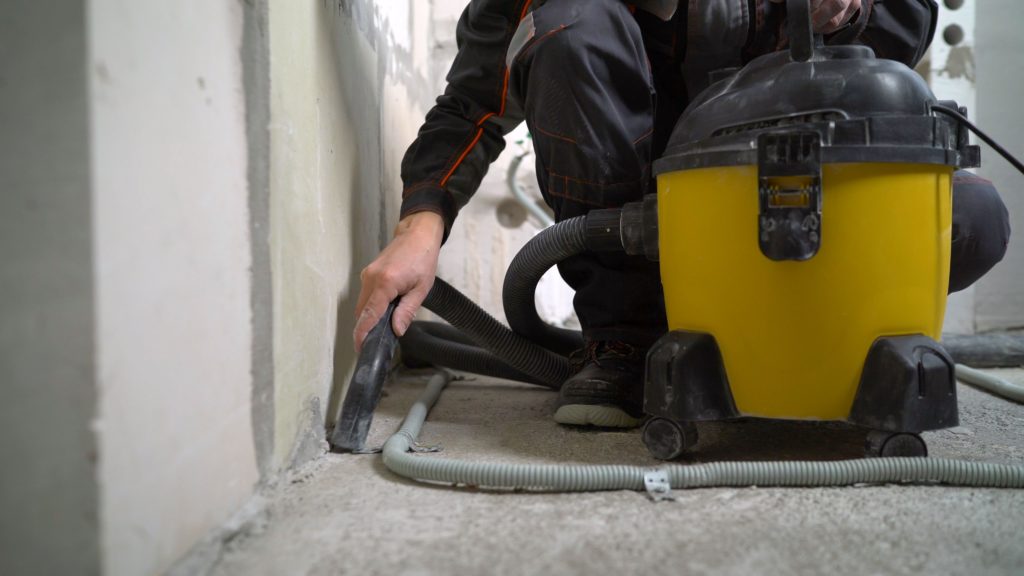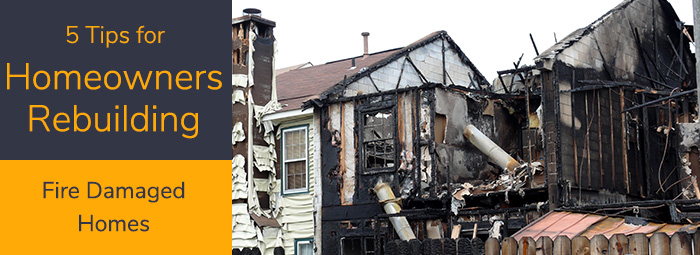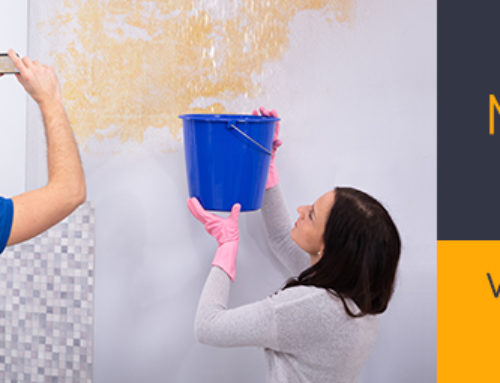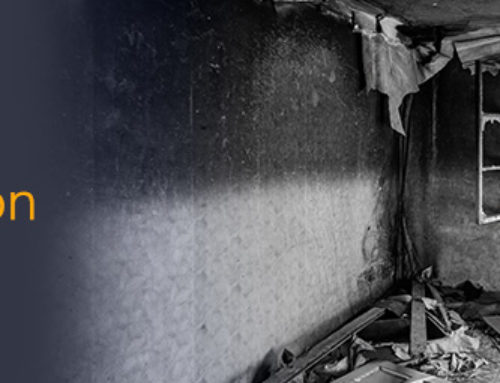Homeowners usually have two options when dealing with the damage a fire causes to a home that is beyond restoration and repair: rebuild it or move on. The irreparable damage may be a single wall, a single room, or an entire story, but even if most of the building is untouched, the damaged part may be enough to deem it unlivable and require rebuilding part of, or most of the home. If you’re considering rebuilding a fire damaged home, there are a number of possible stumbling blocks to be wary of, and tips to help you overcome them.
Summit Reconstruction & Restoration crews are among the best in Portland to help homeowners complete fire and smoke damage restoration and reconstruction. Our employees are IICRC certified in fire, flood, mold, and biohazard remediation. Whether the damage is a result of construction defect or natural disaster, we have the experience, training, and certification to help you find the solution. Continue reading for tips and advice for rebuilding fire damaged homes.
Before the Rebuild
Smoke and fire restoration, repair, and rebuilding can be daunting, and some people think it’s easier to cut their losses and start fresh rather than go through with restoration and repairs. As daunting and labor intensive as it can be, the cost to rebuild a home after a fire is less than starting over. A properly insured owner should only have deductible or upgrade costs. Starting fresh requires everything be brought to current code, including setbacks, footings, foundations, drainage, water and sewer systems, and so on. When you factor in the additional cost and delay of engineering, design, permit application and review, completely replacing a home can often cost more than even substantial repair and restoration.
Please take these numbers with a grain of salt, as your individual needs are going to vary broadly across the country and by company and quality, so keep that in mind. These figures are just ballparks of what tends to be “typical” among companies. It’s reported that homeowners typically pay on average between $2,968 and $28,042, with a national average of $13,404 for a full repair. Others have quoted numbers from $3,000 to $5,000 for smaller fires and $50,000 and up that cause structural damage like roofs or if your kitchen is destroyed. But again, your best bet is always to speak with some qualified experts, and be absolutely sure that you’re working with the best team for the job. You don’t want “minor” damage to drastically degrade the value of your property down the line.
Once you’ve weighed the costs and made the final decision to go through with restoration, there are a series of considerations that need to be addressed, and each one is crucially important to the entire process. Below are some of the tips and advice for homeowners when rebuilding fire damaged homes.
Rebuild Tip 1. Inspection & Evaluation
A safety inspection by a qualified inspector is the first step in a rebuild. Not all companies have a qualified person on staff, Summit does. Qualifications required are the IIRC WRT (Water Restoration Technician) & FSRT (Fire and Smoke Restoration Technician). Inspectors look at a series of categories, including but not limited to:
- Hazardous materials (asbestos or lead based materials)
- Air quality in the house
- The roof
- Plumbing fixtures
- Wiring, electrical circuits, and switches
- Light fixtures
- Fans
- Metal structures
- Concrete (including foundation)
- Siding, and/or stucco
- Flooring
- Interior walls
- HVAC systems
- Mechanical systems (furnace, water heater, sump pumps)
- Doors, windows, and frames
- Damage from fire, smoke, heat, or moisture
- Areas that may be susceptible to mold
This step assesses the damages to a building, which informs you of the nature and repairs required. Inspectors can sometimes answer questions you may not have known to ask.
Rebuild Tip 2. Address Health Hazards
The damage left behind after a fire includes the presence of toxic chemicals. If proper fire restoration is not completed, people occupying the house may suffer respiratory, skin, or eye issues triggered by chemicals left behind after the fire. Signs of exposure to these chemicals include shortness of breath, coughing, bronchitis, and asthma, as well as irritation, itching, redness, and dryness. In addition to these short term risks, there are also long term health risks, including cancer, stroke, heart attack, and serious long term consequences for infants.
Building materials can release toxic chemicals when burned, and those chemicals can contaminate surrounding materials. It’s important to make sure any of the below damaged and affected materials are properly cleaned or removed:
- Plastics
- Carpets
- Fabrics
- Wood products
- Wool
- Foams
- All materials containing asbestos
- PVC
These materials can release and contaminate surrounding materials with hazardous chemicals when ignited, including:
- Hydrogen chloride
- Dioxin chloromethane
- Halocarbons
- Phosgene
- Bromomethane
- Ammonia
- Nitrogen oxide
- Tar
- Hydrogen
- carbon monoxide
Testing to look for the presence of hazardous chemicals or their levels is not necessary. Results from environmental tests are rarely needed to inform the actions people should take to avoid being exposed to smoke and resultant damage. If you want a small sample of how serious this is, consider the massive health risks our brave first responders and firefighters put themselves in to help us.
However, there are some unique situations where environmental testing might be warranted. When environmental testing is necessary, it is usually done for specific, fire-related chemicals and a comprehensive sampling plan is developed so that results are reliable and informative. In these cases, first responders, health and environmental agencies, and others would identify information needed, objectives, and testing methods to provide clear, meaningful results.
Rebuild Tip 3. Summit is on YOUR side!
When a house goes up in smoke, it doesn’t mean your bank account has to do the same to rebuild it. Most home insurance policies cover fire damage to a building, the contents of the building, and the property it sits on. Every insurance policy is different, so review it carefully to understand how much of a rebuild insurance may cover. We will fight for you to make sure your assigned adjuster covers all of the repairs needed.
Rebuild Tip 4. Don’t Forget about Building Permits
In order to do a rebuild, you need permits. Permits are required to ensure that all buildings meet minimum standards that protect its occupants and neighbors in everyday living, and also in case of emergencies or natural disasters. Depending upon the extent of change you will be making to the original structure, the application fees might vary. By selecting Summit, you can rest assured that all necessary permits and inspections will be completed.
Rebuild Tip 5. Consult the Experts
Once you’ve addressed any imminent health concerns, you can get a quote from the experts. Summit Reconstruction & Restoration is a great place to start.
A professional can identify what needs removal and what needs rebuilding, and provide estimated costs.
What to Expect in Fire Restoration & Rebuilding
The goal of fire restoration is to remove any trace that there was a fire in the first place. Fire restoration work involves making sure that the building is structurally sound and utilities are restored to working order. Anything that was affected by the fire is repaired, cleaned, or replaced with the objective of removing any toxins, traces of odors and/or discoloration.
Step 1: Clear out – “Muck out”
Anything with repairable damage will be repaired and restored to its previous condition. After the structural stabilization, demolition will be performed if necessary, as well as the removal of unsalvageable materials. Any belongings that are too damaged for repair will be discarded. This includes everything from furniture and clothing to appliances and electronics.

Step 2: Content Removal & Cleaning
Proper clean-up of smoke and soot residue will remove fire-related compounds so that continuing exposures would no longer be an issue. Everything from the walls, ceilings, flooring, light fixtures, windows, to appliances, upholstery, furniture and all belongings must be cleaned, repaired, or removed.
Anything that was affected by the fire or smoke should be cleaned or disposed of. In most cases, a fire will result in water damage from the loss itself as well as from fire suppression water or foam, so water extraction and remediation are also required. Some of the processes that will take place are:
- Ash, smoke, and soot removal
- Dehumidification and structural drying
- Smoke odor neutralization
- Air purification
- Thermal Fogging
- Ozone treatment
- Ventilation
- Vacuuming
- Cleaning with chemical products
Step 3: Repairing & Rebuilding
Broadly speaking, the most common repairs in fire restoration are mechanical, structural, and cosmetic. Examples of common repairs that take place during fire restoration include:
- Repairing or replacing framing and structural components
- Repairing electrical systems, plumbing, gas pipes, or HVAC
- Replacing insulation, doors, windows, decks, and glass panes
- Re-roofing, re-siding, and trim and siding repair
- Rebuilding stairways and boundary walls
- Replacing flooring, tiles, carpeting, light fixtures, drywall, and plaster
- Redecoration such as whitewashing, painting, or refinishing
- Rebuilding or repairing non-structural walls, smoke chimneys, cabinets and other carpentry
Summit Reconstruction & Restoration is not only the best reconstruction crew in Portland Metro, they’re your one-stop contractors for smoke and fire restoration and rebuild. If you are a property owner who has recently suffered from damage of any kind, we want to help you restore your home to its former glory. Get in touch with us to learn more about what we can do for you.







